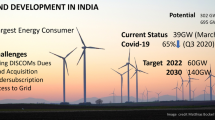Abstract
Being among the most populated country with one of the fastest growing economies in the world, the country is met with ever-increasing fossil fuel consumption. The use of fossil fuels for energy is threatening India with emission pollutants, the import burden of crude oil and natural gas, and coal resource extinction. Clean energies have long been thought to reduce or eliminate a country’s dependence on fossil fuels for electricity generation. In the past decade, India has made major additions to its renewable energy capacity, especially with respect to solar and wind, which represent a major proportion of renewable generation in the country. This paper analyzes the government policies, programs, and incentives to enhance and develop the solar–wind sector in India, alongside potential limitations and solutions. It also reviews the development of “offshore wind,” which is slated to be added to the energy mix of the country over the coming decade.













Similar content being viewed by others
Notes
In an ordinary auction (also known as a 'forward auction'), buyers compete to obtain goods or services by offering increasingly higher prices. In contrast, in a reverse auction, the sellers compete to obtain business from the buyer and prices will typically decrease as the sellers underbid each other.
References
http://www.worldometers.info/world-population/india-population/
https://web.archive.org/web/20180503151432/http://mnre.gov.in/physical-progress-achievements
https://mercomindia.com/solar-2-percent-total-power-generation/
https://www.iea.org/statistics/statisticssearch/report/?country=INDIA&product=indicators&year=2015
https://www.carbonbrief.org/guest-post-why-indias-co2-emissions-grew-strongly-in-2017
https://coal.nic.in/content/production-supplies, https://ujwalbharat.gov.in/
S.K. Guttikunda, P. Jawahar, Atmospheric emissions and pollution from the coal-fired thermal power plants in India. Atmos. Environ. 92, 449–460 (2014)
http://www.wri.org/ {world resource institute}
A. Mani, Wind Energy Resource Survey in India—I (Allied Publishers Limited, New Delhi, 1995), p. 185. ISBN 81-7023-297-X
All India installed capacity of power stations (PDF). March 2018. Retrieved 16 April 2018
SRLDC monthly report, March 2015 (PDF). Retrieved 8 May 2015
https://mnre.gov.in/file-manager/akshay-urja/october-2017/Images/20-25.pdf
https://mnre.gov.in/sites/default/files/webform/notices/RPO%20Compliance%20cell%20order.pdf
https://mercomindia.com/no-ists-charges-wind-solar-projects-commissioned-2022/
http://www.fowind.in/uploads/default/files/report/stuff/bbf012b136f5b4618c619af3a18d960b.pdf
http://niwe.res.in/assets/Docu/FOWIND/FOWIND_2017_Final_Outlook_2032.pdf
http://www.fowind.in/uploads/default/files/report/stuff/f8cedae4da92519cd77be91a6eac2cea.pdf
https://mnre.gov.in/sites/default/files/schemes/Repowering-Policy-of-the-Wind-Power-Projects.pdf
https://mnre.gov.in/sites/default/files/webform/notices/National-Wind-Solar-Hybrid-Policy.pdf
A Research and Development on Renewable Energies: A Global Report on Photovoltaic and Wind Energy, ISPRE (2009)
B. Parida, S. Iniyan, R. Goic, A review of solar photovoltaic technologies. Renew. Sustain. Energy Rev. 15, 1625–1636 (2011)
T.M. Razykov, C.S. Ferekides, D. Morel, E. Stefanakos, H.S. Ullal, H.M. Upadhyaya, Solar photovoltaic electricity: current status and future prospects. Sol. Energy 85, 1580–1608 (2011)
S.M. Moosavian, N.A. Rahim, J. Selvaraj, K.H. Solangi, Energy policy to promote photovoltaic generation. Renew. Sustain. Energy Rev. 25, 44–58 (2013)
C. Philibert, The Present and Future Use of Solar Thermal Energy as a Primary Source of Energy. Solar Thermal Energy. Technical Report. Paris: International Energy Agency (2005). http://www.iea.org/publications/freenewDesc.asp?PUBSID=1574. Accessed 21 Sept 2010
A. Kumara, O. Prakashc, A. Dubec, A review on progress of concentrated solar power in India
S. Pandey, V.S. Singh, Determinants of success for promoting solar energy in India. Renew. Sustain. Energy Rev. 16, 3593–3598 (2012)
A. Kumar, K. Kumar, Renewable energy in India: current status & future potentials. Renew. Sustain. Energy Rev. 14, 2434–2442 (2010)
MNRE. Annual Report, NewDelhi; 2006
N.K. Sharma, P.K. Tiwari, Solar Energy in India: strategies, policies, perspectives & future potential. Renew. Sustain. Energy Rev. 16, 933–941 (2011)
Garud, S, Purohit, I. Making solar thermal power generation in India a reality—overview of technologies, opportunities and challenges, The Energy and Resources Institute (TERI), Darbari Seth Block, IHC Complex, Lodhi Road, New Delhi 110003, India
India’s Solar Power Potential Estimated at 750 GW. http://cleantechnica.com/2014/11/29/indias-solar-power-potential-estimated-750-gw/ Accessed 7 Jan 2015
I. Purohit, P. Purohut, Technical and economic potential of concentrating solar thermal power, generation in India. Renew. Sustain. Energy Rev. 78, 648–667 (2017)
C. Sharma et al., Assessment of solar thermal power generation potential in India. Renew. Sustain. Energy Rev. 42, 902–912 (2015)
S.H. Madaeni, R. Sioshansi, P. Denholm, How thermal energy storage enhances the economic viability of concentrating solar power. Proc. IEEE 100(2), 335–347 (2012)
A.E. Elmohlawy et al., Study and analysis the performance of two integrated solar combined cycle. Energy Procedia 156, 79–84 (2019)
A. Boretti et al., A case study on combined cycle power plant integrated with solar energy in Trinidad and Tobago. Sustain. Energy Technol. Assess. 32, 100–110 (2019)
G. Bonforte et al., Exergo-economic and exergo-environmental analysis of an integrated solar gas turbine/combined cycle power plant. Energy 156, 352–359 (2018)
K. Rashid et al., Techno-economic evaluation of different hybridization schemes for a solar thermal/gas power plant. Energy 181, 91–106 (2019)
M. Mehropooya et al., Investigation of a combined cycle power plant coupled with a parabolic trough solar field and high temperature energy storage system. Energy Convers. Manag. 171, 1662–1674 (2018)
B.J. Alqahtami et al., Integrated solar combined cycle power plants: paving the way for thermal solar. Appl. Energy 169, 927–936 (2016)
K. Yanneti, The grid connected solar energy in India: structures and challenges. Energy Strategy Rev. 11–12, 41–51 (2016)
S. Mukherjee et al., Status of Electricity Act, 2003: A systematic review of literature. Energy Policy
An overview of Indian energy trends, low carbon growth and development challenges, prays energy group, Pune, India (2009)
http://indianpowersector.com/electricity-regulation/national-solar-mission/
“Installed capacity of wind power projects in India”. Retrieved 7 April 2018
T. Kapoor, Scaling up of Grid Connected Solar Power Projects”(PDF). Ministry of New and Renewable Energy. 2015. Archived from the original (PDF) on February 26 (2017)
Share renewables of India: all India installed capacity of utility power stations (pdf). Retrieved 5 April 2018
https://mercomindia.com/mercom-exclusive-solar-tariffs-india-fallen-73-percent-since-2010/
https://assets.kpmg/content/dam/kpmg/in/pdf/2017/09/Solar-beats-coal-cost.pdf
https://www.ft.com/content/a6599b78-f9cc-11e7-9b32-d7d59aace167
https://powermin.nic.in/en/content/power-sector-glance-all-india
https://mercomindia.com/grid-infrastructure-india-solar-wind-tenders/
Mercom Exclusive: Incomplete Solar Park Infrastructure Affecting Large-Scale Project Development in India
T. Muneer, M. Asif, S. Munawwar, Sustainable production of solar electricity with particular reference to the Indian economy. Renew. Sustain. Energy Rev. 9, 444–473 (2005)
Ministry of New and Renewable Energy Sources. Available from: 593 http://mnre.gov.in/file-manager/UserFiles/workshop-gcrt-0870616/german.pdf
P.K.S. Rathore, D.S. Chauhan, R.P. Singh, Decentralized solar rooftop photovoltaic in India: on the path of sustainable energy security. Renew. Energy 131, 297–307 (2019)
Author information
Authors and Affiliations
Corresponding author
Additional information
Publisher's Note
Springer Nature remains neutral with regard to jurisdictional claims in published maps and institutional affiliations.
Rights and permissions
About this article
Cite this article
Singh, A.K., Idrisi, A.H. Evolution of Renewable Energy in India: Wind and Solar. J. Inst. Eng. India Ser. C 101, 415–427 (2020). https://doi.org/10.1007/s40032-019-00545-7
Received:
Accepted:
Published:
Issue Date:
DOI: https://doi.org/10.1007/s40032-019-00545-7




